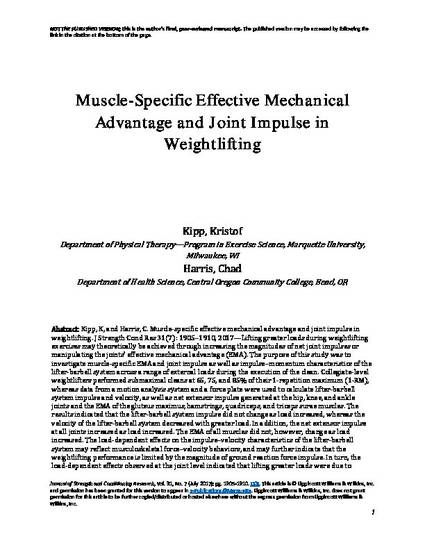
Lifting greater loads during weightlifting exercises may theoretically be achieved through increasing the magnitudes of net joint impulses or manipulating the joints’ effective mechanical advantage (EMA). The purpose of this study was to investigate muscle-specific EMA and joint impulse as well as impulse-momentum characteristics of the lifter-barbell system across a range of external loads during the execution of the clean. Collegiate-level weightlifters performed submaximal cleans at 65, 75, and 85% of their 1-repetition maximum (1-RM) while data from a motion analysis system and a force plate were used to calculate lifter-barbell system impulse and velocity, as well as net extensor impulse generated at the hip, knee, and ankle joints and the EMA of the gluteus maximus, hamstrings, quadriceps, and triceps surae muscles. The results indicated that the lifter-barbell system impulse did not change as load increased, whereas the velocity of the lifter-barbell system decreased with greater load. In addition, the net extensor impulse at all joints increased as load increased. The EMA of all muscles did not, however, change as load increased. The load-dependent effects on the impulse-velocity characteristics of the lifter-barbell system may reflect musculoskeletal force-velocity behaviors, and may further indicate that the weightlifting performance is limited by the magnitude of ground reaction force impulse. In turn, the load-dependent effects observed at the joint-level indicated that lifting greater loads were due to greater net extensor impulses generated at the joints of the lower extremity and not greater EMAs of the respective extensor muscles. In combination, these results suggest that lifting greater external loads during the clean is due to the ability to generate large extensor joint impulses, rather than manipulate EMA.
Available at: http://works.bepress.com/kristof-kipp/2/
Accepted version. Journal of Strength and Conditioning Research (September 2016). DOI. © 2016 Lippincott Williams & Wilkins, Inc. Used with permission.